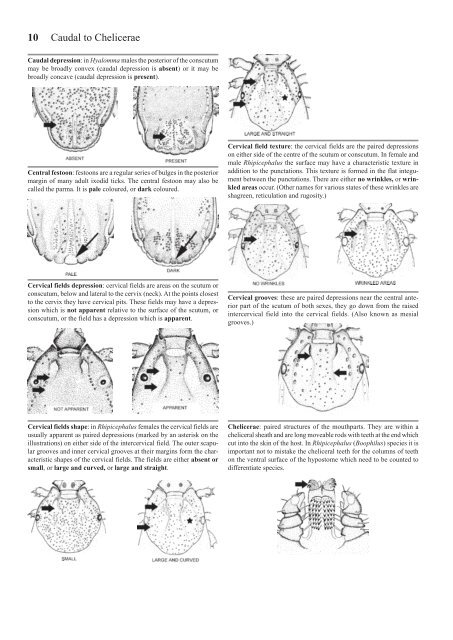Ticks of Domestic Animals in Africa - Alan R Walker - Science Writer
Ticks of Domestic Animals in Africa - Alan R Walker - Science Writer
Ticks of Domestic Animals in Africa - Alan R Walker - Science Writer
You also want an ePaper? Increase the reach of your titles
YUMPU automatically turns print PDFs into web optimized ePapers that Google loves.
10<br />
Caudal to Chelicerae<br />
Caudal depression: <strong>in</strong> Hyalomma males the posterior <strong>of</strong> the conscutum<br />
may be broadly convex (caudal depression is absent) or it may be<br />
broadly concave (caudal depression is present).<br />
Central festoon: festoons are a regular series <strong>of</strong> bulges <strong>in</strong> the posterior<br />
marg<strong>in</strong> <strong>of</strong> many adult ixodid ticks. The central festoon may also be<br />
called the parma. It is pale coloured, or dark coloured.<br />
Cervical fields depression: cervical fields are areas on the scutum or<br />
conscutum, below and lateral to the cervix (neck). At the po<strong>in</strong>ts closest<br />
to the cervix they have cervical pits. These fields may have a depression<br />
which is not apparent relative to the surface <strong>of</strong> the scutum, or<br />
conscutum, or the field has a depression which is apparent.<br />
Cervical fields shape: <strong>in</strong> Rhipicephalus females the cervical fields are<br />
usually apparent as paired depressions (marked by an asterisk on the<br />
illustrations) on either side <strong>of</strong> the <strong>in</strong>tercervical field. The outer scapular<br />
grooves and <strong>in</strong>ner cervical grooves at their marg<strong>in</strong>s form the characteristic<br />
shapes <strong>of</strong> the cervical fields. The fields are either absent or<br />
small, or large and curved, or large and straight.<br />
Cervical field texture: the cervical fields are the paired depressions<br />
on either side <strong>of</strong> the centre <strong>of</strong> the scutum or conscutum. In female and<br />
male Rhipicephalus the surface may have a characteristic texture <strong>in</strong><br />
addition to the punctations. This texture is formed <strong>in</strong> the flat <strong>in</strong>tegument<br />
between the punctations. There are either no wr<strong>in</strong>kles, or wr<strong>in</strong>kled<br />
areas occur. (Other names for various states <strong>of</strong> these wr<strong>in</strong>kles are<br />
shagreen, reticulation and rugosity.)<br />
Cervical grooves: these are paired depressions near the central anterior<br />
part <strong>of</strong> the scutum <strong>of</strong> both sexes, they go down from the raised<br />
<strong>in</strong>tercervical field <strong>in</strong>to the cervical fields. (Also known as mesial<br />
grooves.)<br />
Chelicerae: paired structures <strong>of</strong> the mouthparts. They are with<strong>in</strong> a<br />
cheliceral sheath and are long moveable rods with teeth at the end which<br />
cut <strong>in</strong>to the sk<strong>in</strong> <strong>of</strong> the host. In Rhipicephalus (Boophilus) species it is<br />
important not to mistake the cheliceral teeth for the columns <strong>of</strong> teeth<br />
on the ventral surface <strong>of</strong> the hypostome which need to be counted to<br />
differentiate species.


